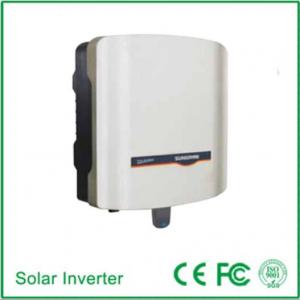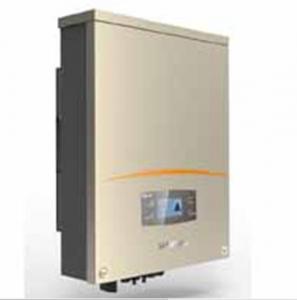Solar Inverter Panel Photovoltaic Grid-Connected Inverter SG50KTL-M
- Loading Port:
- China Main Port
- Payment Terms:
- TT or LC
- Min Order Qty:
- 500000 unit
- Supply Capability:
- 3000000 unit/month
OKorder Service Pledge
OKorder Financial Service
You Might Also Like
1. Structure of Photovoltaic Grid-Connected Inverter SG50KTL-M Description
A solar inverter, or PV inverter, or Solar converter, converts the variable direct current (DC) output of a photovoltaic (PV) solar panel into
autility frequency alternating current (AC) that can be fed into a commercial electrical grid or used by a local, off-grid electrical network.
It is acritical BOS–component in a photovoltaic system, allowing the use of ordinary AC-powered equipment. Solar inverters have
special functions adapted for use with photovoltaic arrays, including maximum power point tracking and anti-islanding protection.
Suitable for 50Hz/60Hz grid, could be used in Asia, Africa and Europe. Available for hand installation, no need for lifting machinery
assistance.
2. Main Features of the Photovoltaic Grid-Connected Inverter SG50KTL-M
• High flexibility for complex configurations due to 4 MPP trackers and a wide input voltage range
• High yields due to efficiency up to 98.9% and EU efficiency of 98.5%
• Output power up to 55kVA / 55kW(SG50KTL-M) and 66kVA / 66kW(SG60KTL-M) at power factor of 1
• Integrated combiner box: 12 x MC4 connector pairs with DC string fuses, Type II overvoltage protection and DC switch, more safety and lower the system cost
• Active power continuously adjustable (0~100%)
• Fulfill a variety of reactive power adjustment requirments with power factor 0.8overexited ~0.8 underexited
• Integrated LVRT and HVRT function
• Includes RS-485 interface, compatible with all common monitoring systems
• Product certification: TÜV, CE, G59/3, BDEW, CGC and GB-T19964
• Manufacturer certification: ISO 9001, ISO 14001, OHSAS 18000
3. Photovoltaic Grid-Connected Inverter SG40KTL Images



4. Photovoltaic Grid-Connected Inverter SG50KTL-M Specification
Side Data | |
Max. PV input power | 56200W |
Max. PV input voltage | 1000V |
Startup voltage | 300V |
Nominal input voltage | 590V |
MPP voltage range | 300~950V |
MPP voltage range for nominal power | 500~850V |
No. of MPPTs | 4 |
Max. number of PV strings per MPPT | 3 |
Max. PV input current | 104A(26A/26A/26A/26A) |
Max. current for input connector | 12A |
Output Side Data | |
Nominal AC output power | 50000W |
Max AC output power(PF=1) | 55000W |
Max. AC output apparent power | 55000VA |
Max. AC output current | 80A |
Nominal AC voltage | 3/N/PE, 230/400Vac |
AC voltage range | 310~480Vac |
Nominal grid frequency | 50Hz/60Hz |
Grid frequency range | 45~55Hz /55~ 65Hz |
THD | < 3 % (Nominal power) |
DC current injection | <0.5 %In |
Power factor | >0.99@default value at nominal power |
(adj. 0.8overexcited ~0.8underexited) | |
Protection | |
Anti-islanding protection | Yes |
LVRT | Yes |
DC reverse connection protection | Yes |
AC short circuit protection | Yes |
Leakage current protection | Yes |
DC switch | Yes |
DC fuse | Yes |
Overvoltage protection | DC Type II DIN rail surge arrester(40kA) |
System Data | |
Max. efficiency | 98.90% |
Max. European efficiency | 98.50% |
Isolation method | Transformerless |
Ingress protection rating | IP65 |
Night power consumption | <1W |
Operating ambient temperature range | -25~60℃(>50℃ derating) |
Allowable relative humidity range | 0~100% |
Cooling method | Smart forced air cooling |
Max. operating altitude | 4000m (>3000m derating) |
Display | Graphic LCD |
Communication | RS485 |
DC connection type | MC4 |
AC connection type | Screw Clamp terminal |
Certification | VDE0126-1-1,EN62109-1,EN62109-2,G59/3, |
BDEW,GB/T 19964, GB/T 29319 | |
Mechanical Data | |
Dimensions(W×H×D) | 665 * 906 * 256 mm |
Mounting method | Wall bracket |
Weight | 70kg |
5. FAQ of Photovoltaic Grid-Connected Inverter SG50KTL-M
Q1. What is the difference between inverter and solar inverter?
A1. Inverter only has AC inpput, but solar inverter both connect to AC input and solar panel, it saves more power.
Q2. What is the difference between MPPT&PWM?
A2. MPPT has higher efficiency, it can track the max power point and won't waste energy.
- Q: How does a solar inverter handle variations in ambient temperature?
- A solar inverter handles variations in ambient temperature by incorporating temperature compensation mechanisms. These mechanisms allow the inverter to adjust its operation and optimize performance based on the temperature conditions. By monitoring the temperature, the inverter can regulate voltage levels, adjust power outputs, and protect itself from overheating. This ensures that the inverter operates efficiently and reliably under different ambient temperature conditions.
- Q: Can a solar inverter be used with concentrated photovoltaic thermal systems?
- Yes, a solar inverter can be used with concentrated photovoltaic thermal (CPVT) systems. A solar inverter is used to convert the direct current (DC) generated by the CPVT system into alternating current (AC) that can be used to power electrical devices or be fed into the grid.
- Q: What is the role of reactive power control in a solar inverter?
- The role of reactive power control in a solar inverter is to manage and optimize the flow of reactive power between the solar PV system and the grid. This control allows the inverter to regulate the power factor, which is the ratio of real power to apparent power, ensuring that the system operates efficiently and in compliance with grid requirements. By adjusting the reactive power output, the inverter can compensate for voltage fluctuations and stabilize the grid, improving the overall performance and reliability of the solar power generation system.
- Q: What is the role of reactive power injection in a solar inverter?
- The role of reactive power injection in a solar inverter is to help maintain the stability and quality of the electrical grid. Reactive power is required to regulate voltage levels and compensate for any imbalances or fluctuations in the grid. By injecting reactive power, a solar inverter can ensure that the power generated from the solar panels is in sync with the grid's voltage and frequency, helping to maintain proper power flow and prevent potential issues such as voltage sags or surges.
- Q: Can a solar inverter be used with different types of tracking algorithms?
- Yes, a solar inverter can be used with different types of tracking algorithms. The inverter is designed to convert the DC power generated by solar panels into usable AC power for various applications. The tracking algorithm, on the other hand, is responsible for optimizing the solar panel's orientation to maximize energy production. Different tracking algorithms like fixed tilt, single-axis, or dual-axis can be employed with the solar inverter to enhance energy harvesting based on factors such as sun's position, time of day, and weather conditions.
- Q: What are the methods of photovoltaic grid-connected inverter control
- and can set the dead time between the upper and lower arms, the use of INTEL 80C196MC to achieve sine wave output circuit, 80C196MC to complete the sine wave signal, AC output voltage, to achieve regulation. Circuit output generally use LC circuit filter high frequency wave, get pure sine wave.
- Q: Can a solar inverter be connected to a backup battery system?
- Yes, a solar inverter can be connected to a backup battery system. This allows the solar energy generated during the day to be stored in the backup battery system and used during times when the sun is not shining or during power outages.
- Q: Can a solar inverter provide power during a blackout?
- No, a solar inverter cannot provide power during a blackout.
- Q: What is the role of a solar inverter in a solar-powered remote monitoring system?
- The role of a solar inverter in a solar-powered remote monitoring system is to convert the direct current (DC) electricity generated by the solar panels into alternating current (AC) electricity that can be used to power the monitoring system. It also ensures that the electricity generated matches the requirements of the monitoring equipment, regulates the voltage, and assists in efficient power transmission and distribution.
- Q: How do you choose the right size of solar inverter for a system?
- When choosing the right size of solar inverter for a system, it is important to consider the total capacity of the solar panels and the expected power output. The inverter should have a capacity that matches or slightly exceeds the maximum power output of the panels to ensure optimal efficiency. Additional factors such as the type of grid connection and any future expansion plans should also be taken into account. Consulting with a professional solar installer or conducting a thorough system assessment can help determine the appropriate size of the inverter for a given solar system.
Send your message to us
Solar Inverter Panel Photovoltaic Grid-Connected Inverter SG50KTL-M
- Loading Port:
- China Main Port
- Payment Terms:
- TT or LC
- Min Order Qty:
- 500000 unit
- Supply Capability:
- 3000000 unit/month
OKorder Service Pledge
OKorder Financial Service
Similar products
Hot products
Hot Searches
Related keywords




























